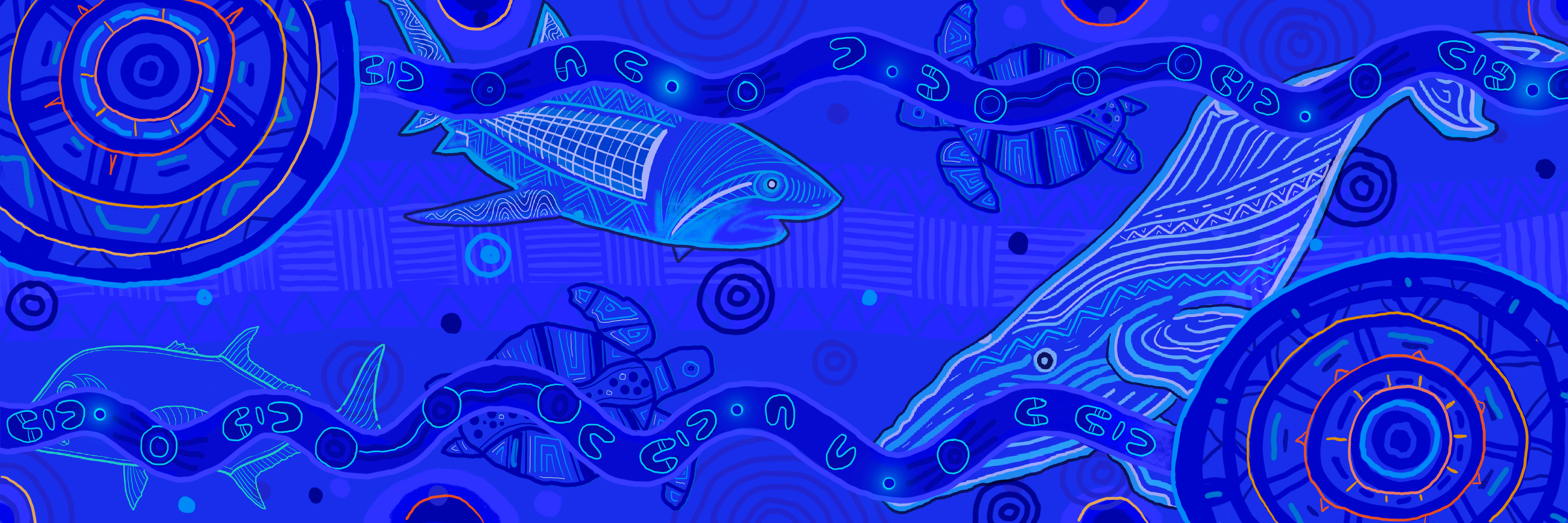Indigenous Australians have conducted fishing and aquaculture across this land for tens of thousands of years, maintaining and managing the natural resources for sustenance, and in balance with the broader ecosystem. The evidence is plentiful, displayed around the coasts as middens, in the remnants of fish traps, across many rock murals, and in aquaculture networks such as those at Budj Bim in Victoria and Brewarrina in NSW. It is an embedded cultural practice shared between generations.
Words Annabel Boyer | Illustration Beau Pennefather Motlop
The FRDC has developed an Indigenous Statement of Intent in recognition of the continued tenure over and connection with their traditional lands and waters that Aboriginal and Torres Strait Islander peoples have had for tens of thousands of years. This document also recognises that the past two centuries have led to the dispossession and alienation of Australia’s Indigenous peoples, who continue to face both social and economic disadvantage, requiring intent and action to remediate.
The journey
The Statement is the latest step on a journey the FRDC has been taking for some time. At 2017’s Seafood Directions conference, FRDC managing director Patrick Hone identified a number of goals for the Australian seafood industry. These included recognising that Indigenous culture, in which fishing has been a way of life for thousands of years, is the shared culture of all Australians and improving the participation of young people and Indigenous people in the sector.
The Statement has recently been endorsed by the FRDC’s board; it formalises the organisation’s aspirations and outlines a range of activities to realise those aspirations.
A decade ago the FRDC set up its Indigenous Reference Group (IRG) to help guide the FRDC in its investments in relation to Indigenous fishing and aquaculture. While the IRG will continue its advisory role, the Statement of Intent embeds these aspirations within both the internal culture of the FRDC and the research and development activities it funds across its entire portfolio.
As well as directly funding research activities, the FRDC will seek to act as a conduit in the space for Indigenous fishing. This includes linking with organisations seeking to do similar work, such as the Indigenous Land and Sea Corporation, CSIRO, the Department of Agriculture, Water and the Environment, and various state governments.
Broadly, the FRDC commits to:
- acknowledge the special relationship Aboriginal and Torres Strait Islander peoples have with their traditional lands and waters, and the plants and animals that exist in those lands and waters;
- value the experiences, knowledge, perspectives and cultures of Aboriginal and Torres Strait Islander peoples and seek their input; and
- seek prior informed consent from Aboriginal and Torres Strait Islander peoples in any projects in which they are involved that utilise their knowledge or have benefits or outputs relevant to them.
The Statement’s adoption will have flow-on effects for a myriad of FRDC activities. As an example FISH magazine will make a point of acknowledging the sea or land country where our stories take place, where possible. For example, an article about research taking place in Narooma, on the south coast of New South Wales, will acknowledge that this is Yuin country.

Indigenous heritage
Illustrator Beau Pennefather Motlop has links to Djirrabal Tribe (Aboriginal) and Wagedoegam Tribe (Torres Strait Islander) through his mother’s family and Ngapuhi (New Zealand Maori) on father’s side.
Visualising intention
The FRDC has commissioned this illustration from Indigenous artist Beau Pennefather Motlop to reflect its Statement of Intent.
The fish, animals and circular elements with ochre and orange represent the special relationship Aboriginal and Torres Strait Island peoples have with their lands and waters, plants and animals.
The woven textures in the background represent the sharing of knowledge, ideas and perspectives of Aboriginal and Torres Strait Islander peoples integrated into decision-making and management.
The symbols within the snake-like lines depict meetings between people, sharing knowledge then going away to find information; lines connecting people show a gathering and sharing of knowledge.
The running water hole – three circles and connecting streams – depicts aquaculture.
A broader movement
With its adoption of the Indigenous Statement of Intent, the FRDC joins a movement that stretches across Australian society and involves a great diversity of individuals and organisations working towards a common goal. The FRDC adopts the vision expressed by Reconciliation Australia: “A united Australia which respects this land of ours, values the Aboriginal and Torres Strait Island heritage and provides justice and equity for all.”
It also acknowledges that to achieve reconciliation and beneficial outcomes for Indigenous Australians we must embed and involve Indigenous peoples and culture in all relevant research activities and structures.
While the FRDC had the opportunity to adopt a Reconciliation Action Plan, which is the more common pathway forward, the FRDC chose to start by adopting the Statement of Intent. This course of action acknowledges that we are at the beginning of a journey.
We can take action within the internal operations of the organisation and externally, in how we fund research, development and extension.
In reviewing progress each year we will continue to learn where the FRDC can have the most relevant impact to help Indigenous Australians maintain and build their cultural connection to Australia’s natural resources.
More information
The full Statement of Intent will be posted on the FRDC’s website





